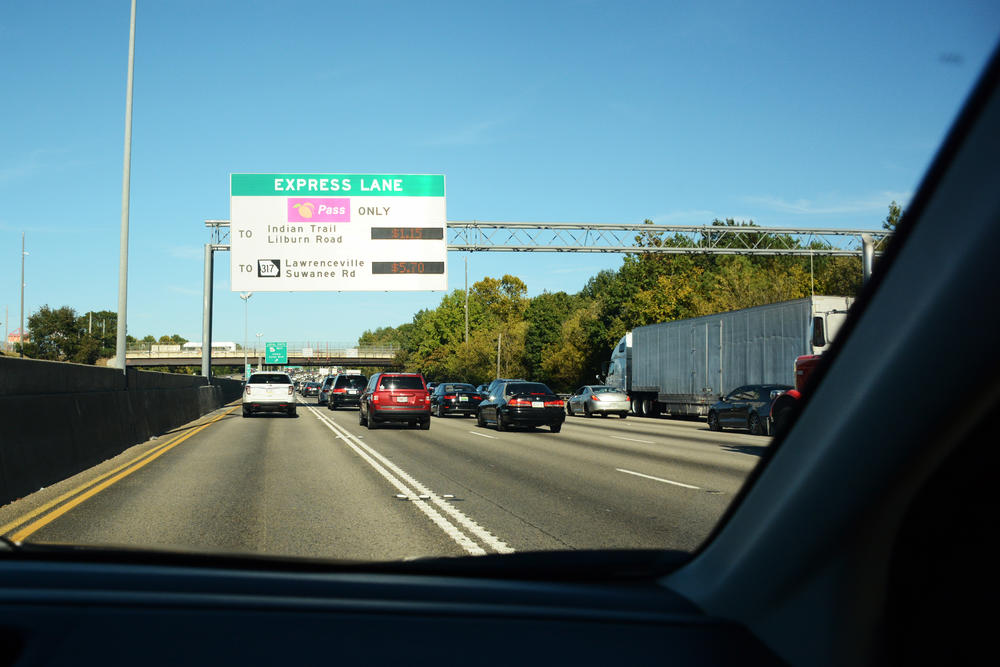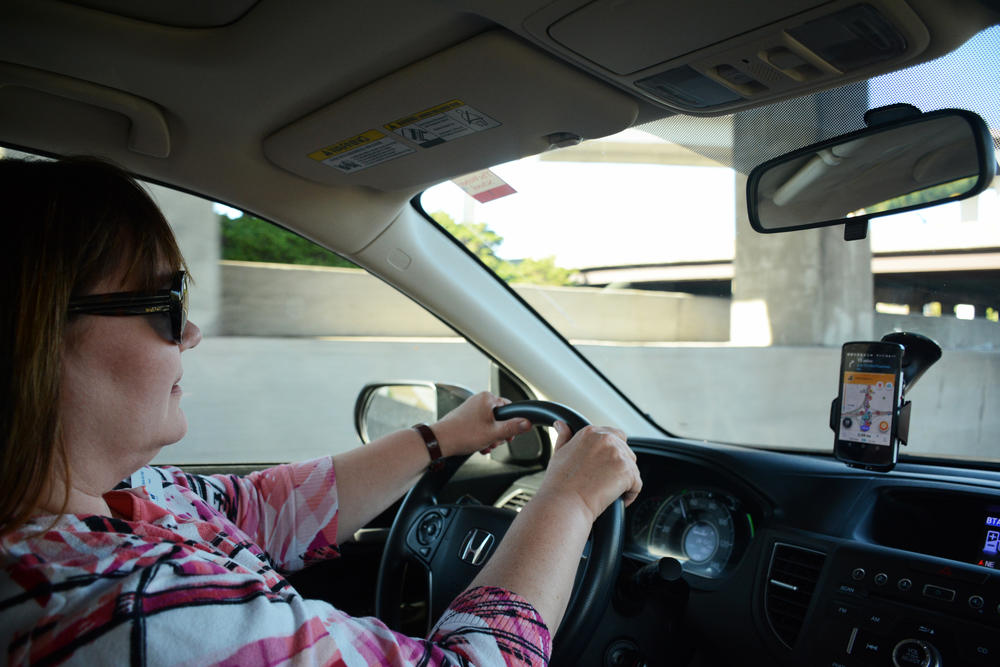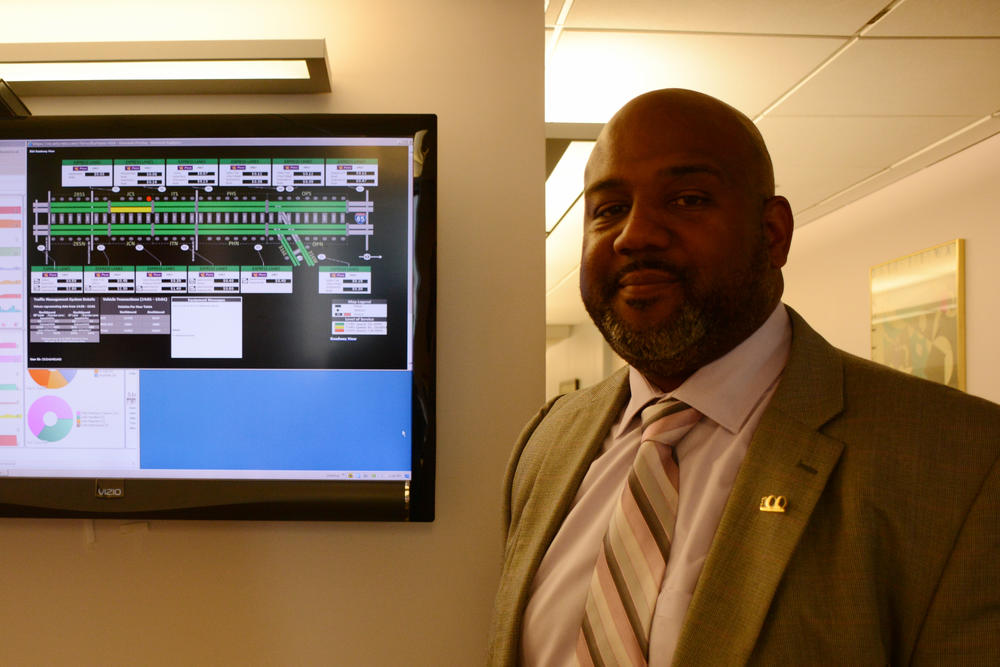Section Branding
Header Content
Express Lanes Take Toll On Driver Behavior
Primary Content
What would you do to keep from sitting in traffic?
Drivers on a stretch of I-85 north of Atlanta confront that question each time they pass a set of limited access toll lanes.
The idea is simple: pay the toll, and move faster. The worse the traffic, the higher the toll.
But toll prices are rising, and that's raising questions about the true costs and benefits of the system just as the state builds similar lanes around metro Atlanta.
As of late, that’s been on the mind of Shlaina VanDyke, who uses the lanes during her regular commute from Suwanee to Sandy Springs.
During a recent Monday afternoon rush hour, she encountered what she said was an average toll.
“Seven dollars to Lawrenceville Suwanee Road,” she said, eyeing a large sign above the roadway that broadcasts the toll rates. “That’s not a bad price for this time of day.”
VanDyke pulled into the express lane and started zipping by other cars. She’d be taking the lane its full 16 miles, which meant she’d pay the highest toll.
Users who use the lanes for shorter distances pay lower tolls. All tolls are charged to Peach Pass accounts, which drivers can create for no cost.
On average, VanDyke said the lanes shave about 30 minutes off her commute each day, which still takes her about one hour each way.
For that, she pays about $60 a week, though, lately, prices have been rising. Just recently, she paid $13.95 for a one-way trip on a day when the lanes' tolls reached record levels.
“And then when you get in the [express] lane, and you're still averaging 20 mph, and there are times when you are stopped: it’s an exercise in frustration,” she said.
VanDyke said the lanes feel less and less like they’re worth the money, but the only alternative seems to be sitting in traffic. So, she feels stuck.
“I would liken it to a bad marriage but divorce is not an option kind of thing,” she said.
“Everybody focuses on being stuck in traffic. They rarely focus on: we are the traffic,” said Chris Tomlinson, Executive Director of the State Road and Tollway Authority, the agency that runs the lanes.
The toll formula is simple: more traffic means higher prices. But Tomlinson stressed the lanes aren’t meant to generate revenue. They actually run at a loss.
“Have we created an option in these heavily congested corridors that can perform better than all of the other choices in that corridor, at least on the highway? That’s what we’re trying to do,” Tomlinson said.
The lanes were launched as part of an effort to reduce congestion in the busy I-85 corridor north of Atlanta at peak times. There’s a federal standard for judging how well they do that: maintaining average speeds of 45 miles per hour.
“And if you fall below the standards, [the federal government] wants to know what measures you’re going to take," Tomlinson said. “We actually received a letter from the federal government saying raise the prices.”
So, the toll authority raised prices, and drivers paid them just like they did every other time tolls were raised.
“It feels expensive,” Tomlinson said. "What we’ve been watching is as the prices have gone up...we continue to see more riders using the lane.”
As of August 2016, more than 28,000 drivers were using the lanes each weekday, a figure that has increased steadily since the lanes opened.
Pat McCarthy studies transportation economics at Georgia Tech. He said the rising demand for the lanes speaks to drivers’ priorities.
“What it fundamentally says is that the value of that trip to those individuals is worth the cost,” he said.
McCarthy explained that road space is a fixed resource. Eventually drivers will decide the costs of using that resource--either paying the toll or sitting in traffic--are too high and change their behavior.
“Not everyone buys a Rolls-Royce,” he said. “Some people buy less expensive cars. We figure out based upon our incomes what choices we want to make.”
Some drivers could choose not to use the lanes and risk sitting in traffic. But others could change their commute schedules, hop on transit, or telecommute: all of which could help reduce congestion.
McCarthy said the express lanes can do even more than impact driver behavior.
“It also gets individuals thinking about roads as they might think about a typical product that they pay for,” he said.
The express lanes have had that effect on Shlaina VanDyke, who said she’s weighing their costs and benefits more and more as toll prices continue to rise.
“There is a ceiling for me,” she said, ruminating on how much she’d pay to use the lanes. “It’s one of those things that you really have to decide what your priorities are.”
VanDyke’s priority is spending time with her family. For now, she’s still willing to pay the toll for an extra half hour a day with her husband and daughter. But if that payoff continues shrinking, she’s ready to consider other options.
“You start re-evaluating. For me, I’d have to re-evaluate where I work,” she said.
Pretty soon, many more drivers in metro Atlanta will have the chance to weigh those costs and benefits. The state plans to open 50 more miles of tolled express lanes by 2018 with even more planned for the future.





